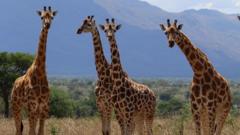In a groundbreaking advancement for wildlife conservation, the International Union for Conservation of Nature (IUCN) has officially recognized four distinct species of giraffes, adding three more to the previously believed single species. This revelation is pivotal for understanding giraffe biodiversity and enhancing conservation efforts.
Recent studies focused on the skull structures and head shapes of giraffes across the African continent provided compelling evidence for categorizing them into separate species. Researchers indicated that geographical barriers—such as deserts, rivers, and valleys—have historically contributed to the evolution of these magnificent creatures in isolation, leading to notable genetic variations.
The first of the newly acknowledged species is the Southern giraffe, predominantly residing in South Africa, Angola, and parts of several neighboring countries. It is believed that geographic features like the Kunene and Zambezi Rivers, alongside dense rainforests, have played a crucial role in separating these giraffes from other groups.
Next is the Reticulated giraffe, which inhabits the savannahs and grasslands of Kenya, Somalia, and Ethiopia. Researchers have identified physical separations caused by features like the Tana River and local mountainous regions, leading to its classification as a distinct species. The Reticulated giraffe is also known for its migratory patterns, creating additional complexities in genetic mixing with other giraffes.
The Northern giraffe, found across Ethiopia, Kenya, South Sudan, and Uganda, is the third species identified. Separation from other giraffes in its habitat is attributed to natural landmarks like the Nile River and Lake Victoria.
Finally, the Masai giraffe, characterized by its unique spotted coat, is found in Kenya and Tanzania. Though visually similar to the Northern giraffe, its geographical extension around major rivers signifies its status as a separate species.
Highlighting the significance of these findings, co-author Michael Brown from IUCN mentions, "Identifying genetic differences is vital for conservation." Previously classified as one vulnerable species, the giraffe's new treatment will enable tailored conservation strategies for each identified species. The IUCN aims to reassess the conservation status of these four species, enhancing protection efforts for giraffes on the brink of extinction.






















